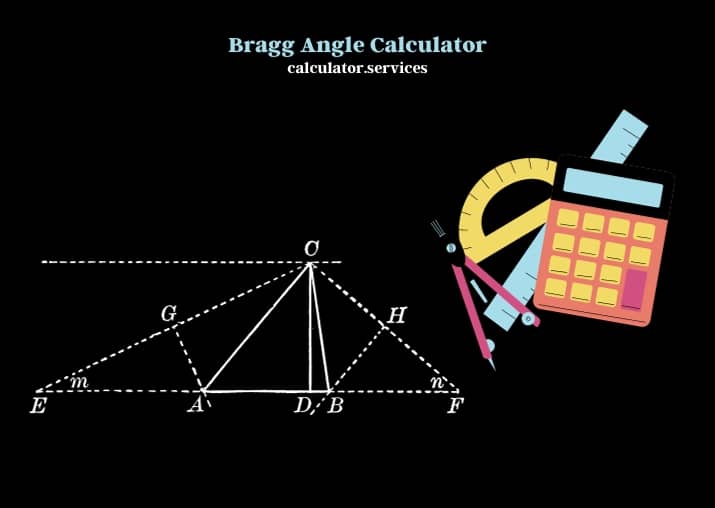Published on: December 30, 2023
Created by Calculator Services Team / Fact-checked by Monjurul Kader
Bragg Angle Calculator
A Bragg angle calculator is an essential tool for scientists and students in the field of crystallography. It simplifies the process of calculating the angle at which light or x-rays are diffracted by a crystal lattice. The Bragg angle is pivotal in determining the crystal structure, which is fundamental in materials science, chemistry, and physics.
The calculator operates on Bragg’s Law, which relates the angle of incidence with the wavelength of light and the distance between the crystal planes. By inputting the wavelength and the lattice spacing, users can swiftly calculate the Bragg angle. This tool is particularly useful in laboratories and educational settings where quick and accurate calculations are needed. It eliminates the need for complex manual calculations, thereby saving time and reducing the potential for error.

The user-friendly interface of the Bragg angle calculator makes it accessible to both experts and novices. It serves as a practical educational resource for students learning about crystallography. By providing instant results, it aids in a better grasp of the underlying principles of x-ray diffraction and crystal structure analysis.
For those interested in the intricacies of crystallography and its applications, the Bragg angle calculator is a valuable asset. We invite you to read the detailed article below to gain more insights into its functionality and applications in various scientific fields.
See More Useful Calculators:
- Bob Weight Calculator
- Aluminum Coil Weight Calculator
- BPM Pitch Calculator
- Banshee Gearing Calculator
- Aluminum Coil Calculator
- Acme Screw Torque Calculator
Bragg’s Law
The Foundation of Bragg Angle Calculations
Bragg’s Law is the cornerstone of understanding how light or x-rays scatter off crystal surfaces. It’s like a roadmap that guides scientists in deciphering the atomic structure of crystals. This law is crucial in fields like material science and chemistry, where knowing the arrangement of atoms helps in understanding the properties of materials.
Bragg Angle Calculation Formula
Mathematical Expression of Bragg’s Law
At the heart of Bragg’s Law lies a simple yet elegant equation:
nλ = 2d sin(θ). Here,nrepresents the order of diffraction, a whole number indicating the scale of the diffraction pattern. The symbolλstands for the wavelength of the incoming wave, typically in nanometers.dis the distance between the crystal planes, andθis the Bragg angle, the angle of incidence that we’re keen to calculate. This formula is a bridge connecting the microscopic lattice structure of a crystal to the macroscopic world of observable diffraction patterns.
Applications in Crystallography
Real-World Uses of Bragg Angle Calculations
In the realm of crystallography, Bragg’s Law is like a Swiss Army knife. It’s a versatile tool used in various applications. For instance, in material science, it helps in identifying new materials and understanding their properties. In the world of x-ray crystallography, it’s indispensable for determining the structure of complex molecules like proteins, which is essential in drug development.
Comparative Analysis
Bragg Angle in Different Materials
To illustrate the practicality of Bragg’s Law, let’s look at a table comparing the Bragg angle for different materials:
| Material | Lattice Spacing (nm) | Bragg Angle (°) |
|---|---|---|
| Silicon | 0.543 | 23.45 |
| Diamond | 0.356 | 29.75 |
| Sodium Chloride | 0.564 | 22.35 |
This table shows how varying lattice spacings in different materials lead to different Bragg angles when exposed to x-rays of a fixed wavelength.
Practical Examples

Step-by-Step Calculation Scenarios
Let’s walk through a couple of examples to see Bragg’s Law in action. Imagine we’re working with silicon and we know its lattice spacing is 0.543 nm. If we’re using x-rays with a wavelength of 0.154 nm, and we’re observing the first order of diffraction (n=1), we can calculate the Bragg angle. Plugging these values into our formula, we find that the angle is approximately 23.45°. This angle is where we’d expect to see the peak of diffracted x-rays off the silicon crystal.
Summary
In this article, we’ve journeyed through the landscape of Bragg’s Law, from its fundamental principles to its practical applications. We’ve seen how a simple equation can reveal the hidden structure of materials and how this knowledge is applied in various scientific fields. The Bragg angle calculator, a tool built on this law, serves as a bridge between theoretical physics and practical experimentation, proving its value in scientific advancements.
